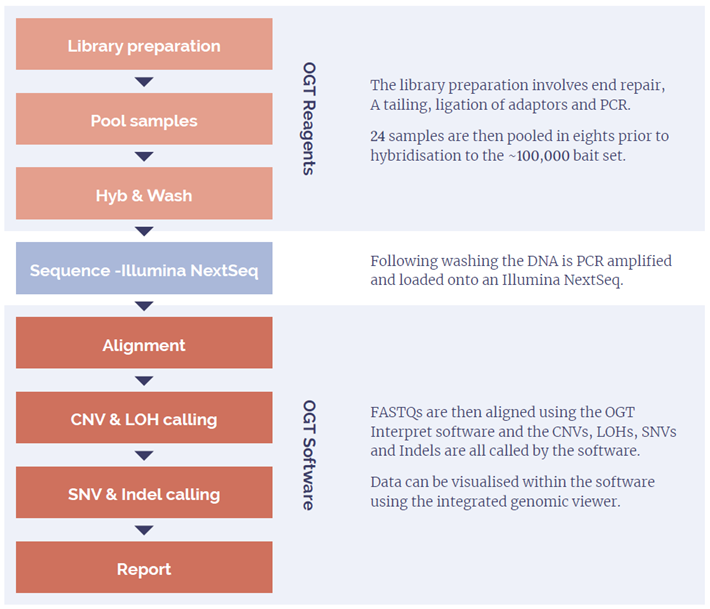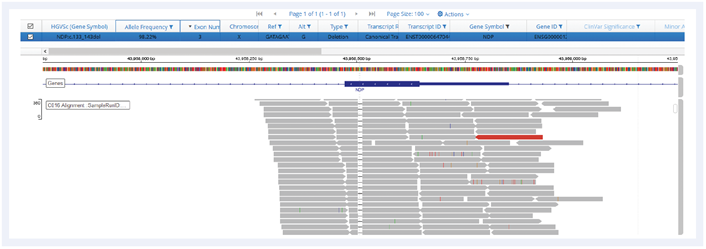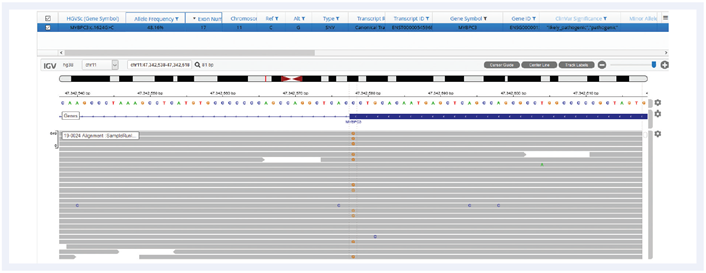Want to download this as a PDF? Download now
Emma Shipstone, James Reid, Sandra Kachhia, John Shovelton, Duarte Molha, Christina Taylor, Jagath Kasturiarachchi, Jolyon Holdstock, Venu Pullabhatla, Laura Parkes, Natalie Milner, Douglas Hurd
Array comparative genomic hybridization (aCGH) has been used extensively in research to determine the causative copy number variation (CNV) in Intellectual Disability (ID) and Development Delay (DD) cases1. Microarrays have a limitation in that they cannot detect single nucleotide variations (SNVs), which may be causative. Conversely, robust small CNV calling via other genetic techniques, e.g. exome sequencing has remained challenging. To overcome these issues, we have designed an NGS assay and supporting analytical software that reliably detects a wide range of aberration types, including:
The 700 targeted genes known to be important in ID and DD were carefully selected on the basis of ClinGen2 and DDD3 guidelines. The ability to detect these 4 different types of aberration significantly improves the likelihood of detecting causative aberrations compared to aCGH alone.
Outlined here is the design and testing of the assay using research samples obtained from cytogenetic laboratories. A particular focus of the testing has been confirmation that the CNV detection capabilities of the assay are as good as those obtained with aCGH (Figures 1-7). This has included testing with mosaic samples. We have demonstrated excellent concordance between the results obtained with the new assay and aCGH.

 Figure 1: [A] ~80kb duplication detected on chromosome 2 with both CytoSure® Constitutional NGS and [B] CytoSure Constitutional v3 4x180k array.
Figure 1: [A] ~80kb duplication detected on chromosome 2 with both CytoSure® Constitutional NGS and [B] CytoSure Constitutional v3 4x180k array.
 Figure 2: [A] Single exon deletion in a female DMD sample detected with CytoSure NGS and [B] CytoSure Constitutional v3 4x180k array.
Figure 2: [A] Single exon deletion in a female DMD sample detected with CytoSure NGS and [B] CytoSure Constitutional v3 4x180k array.
 Figure 3: [A] 753kb deletion detected on chromosome 8 on CytoSure Constitutional NGS and [B] on a 4x180k CytoSure Constitutional v3 array CGH.
Figure 3: [A] 753kb deletion detected on chromosome 8 on CytoSure Constitutional NGS and [B] on a 4x180k CytoSure Constitutional v3 array CGH.
 Figure 4: [A] 1.4Mb duplication on chromosome 17 shown with the Interpret software on CytoSure Constitutional NGS. [B] The matching array result with CytoSure Interpret software using a CytoSure 4x180k v2 ISCA array.
Figure 4: [A] 1.4Mb duplication on chromosome 17 shown with the Interpret software on CytoSure Constitutional NGS. [B] The matching array result with CytoSure Interpret software using a CytoSure 4x180k v2 ISCA array.
 Figure 5: [A] 8.8Mb stretch of LOH on chromosome 7 with a 213kb duplication on CytoSure Constitutional NGS. [B] Equivalent 4x180k CytoSure Constitutional custom array.
Figure 5: [A] 8.8Mb stretch of LOH on chromosome 7 with a 213kb duplication on CytoSure Constitutional NGS. [B] Equivalent 4x180k CytoSure Constitutional custom array.
 Figure 6: Detection of an indel within the NDP gene on chromosome X.
Figure 6: Detection of an indel within the NDP gene on chromosome X.
 Figure 7: Detection of an SNV in the MYBPC3 gene.
Figure 7: Detection of an SNV in the MYBPC3 gene.
 Figure 8: Summary of results from overall study.
Figure 8: Summary of results from overall study.
We have demonstrated that CytoSure Constitutional NGS was able to detect CNVs with excellent concordance to microarrays, but has the added benefit of SNV/Indel and LOH calling. We were able to call all the CNVs from our research sample trial at an independent lab providing confidence in the NGS solution. We were also able to call the SNV aberrations from our research samples, providing a rich new source of genetic information in comparison to microarray alone.
CytoSure®: For Research Use Only; Not for Diagnostic Procedures.
